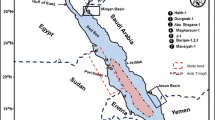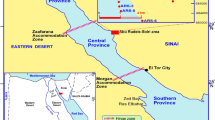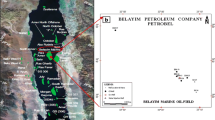Abstract
This study evaluates the hydrocarbon generation potentials and time of generation for Paleocene to Lower Miocene source rock horizons from A-1, B-1, B-2, and C-1 wells in the Niger Delta Basin using 1D Petromod modeling software. Wells A-1, B-1 and B-2, and C-1 are located within the Central Swamp, the Coastal Swamp, and the Shallow Offshore depobelts, respectively. The thermal history was derived from the rifting–subsidence heat flow model. Maturity modeling were carried out by using Easy%Ro kinetic model and a heat flow history predicting present-day heat flow which were calibrated with measured temperature data. Results of the study suggest that these potential source rocks have attained maturity status to generate hydrocarbons, with vast differences existing in the timing of the onset of oil generation. Basin modeling suggests that Paleocene source rocks entered the oil generative window from the Oligocene to Miocene times with thermal maturity window that varies from gas generation to early-mature phase. The Eocene source rocks have also attained maturity from Miocene to Pliocene times, and their thermal maturity ranges from gas generation to early maturity stage. The Oligocene source rocks also began to generate oil during the Miocene and are currently within the early-mature to mid-mature stage. The thermal maturity window for the Lower Miocene source rocks ranges from immature to early-mature stage. The present modeling results reveals that higher levels of thermal maturity are attained in areas with high geothermal gradients and heat flow values while the cooler areas exhibits lower levels of maturation. The onset of the oil window lies at 2859 m at A-1 (Central Swamp), 3240 m at B-2 (Coastal Swamp), 4732 m at B-1 (Coastal Swamp), and 4344 m at C-1 (Shallow Offshore). The depth to the onset of oil window is found deeper in the Shallow Offshore and western parts of the study area than in the eastern and northwestern parts. The result of this study suggest that the Paleocene, Eocene, Oligocene, and Lower Miocene source rocks are the principal source rocks for oil and gas generation in the Niger Delta Basin.












Similar content being viewed by others
References
Akpabio I, Ejedawe J, Ebeniro J (2013) Thermal state of the Niger Delta Basin. Proceedings of the 18th workshop on Geothermal Reservoir Engineering, Stanford University, Stanford, California, February, pp 11–13.
Akpabio IO, Ejedawe JE, Ebeniro JO, Uko ED (2003) Geothermal gradients in the Niger Delta Basin from continuous temperature logs. Global Journal of Pure and Applied Sciences 9(2):265–272
Allen PA, Allen JR (1990) Basin analysis—principles and applications. Blackwell Scientific Publications, London, 449 p
Avbovbo AA (1978) Geothermal gradients in southeastern Nigerian Basin. Bulletin, Canadian Association of Petroleum Geologists 26:269–274
Burke KC, Dessauvagie TFJ (1971) Whiteman AJ. The opening of the Gulf of Guinea and the geological history of the Benue depression and the Niger Delta: Nature: Physical Science 233:51–55
Burnham AK (1989) A simple kinetic model for petroleum formation and cracking. Lawrence Livermore National Laboratory report, UCID – 21665
Bustin M (1988) Sedimentology and characteristics of dispersed organic matter in Tertiary Niger Delta. Origin of source rocks in a Deltaic environment. Am Assoc Pet Geol Bull 72(3):277–298
Chukwueke C, Thomas G, Delfraud J (1992) Sedimentary processes, eustatism, subsidence and heat flow in the distal parts of the Niger Delta. Bull Centres Rech Exploration–Production Elf–Acquitaine 16(1):137–186
Corredor F, Shaw JH, Bilotti F (2005) Structural styles in the deep-water fold and thrust of the Niger Delta. Am Assoc Pet Geol Bull 89:753–780
Doust H, Omatsola E (1990) Niger Delta. In: Edwards JD, Santogrossi PA (eds) Divergent/passive margin basins, American Association of Petroleum Geologists Memoir, vol 48, pp. 201–238
Ekweozor CM, Daukoru EM (1994) Northern delta depobelt portion of the Akata–Agbada petroleum system, Niger Delta. In: Magoon LB, Dow WG (eds) The petroleum system—from source to trap. AAPG Mem 460:599–613
Ekweozor CM, Okoye NV (1980) Petroleum source - bed evaluation of Tertiary Niger Delta. Am Assoc Pet Geol Bull 64:1251–1259
Ekweozor CM, Okogun JI, Ekong DEU, Maxwell JM (1979) Preliminary organic geochemical study of samples from the Niger Delta (Nigeria). Chem Geol 27:29–37
Evamy BD, Haremboure J, Kamerling P, Knaap WA, Molloy FA, Rowlands PH (1978) Hydrocarbon habitat of the Tertiary Niger Delta. Am Assoc Pet Geol Bull 62:1–39
Frost BR (1977) Structure and facies development of the Niger Delta resulting from hydrocarbon maturation. Am Assoc Pet Geol Bull 80:1291
Haack RC, Sundaraman P, Dahl J (1997) Niger Delta Petroleum system. In: Extended Abstracts, AAPG/ABGP Hedberg Research symposium, Petroleum Systems of the South Atlantic margin, November 16–19, 1997, Rio de Janerio, Brazil.
Hantschel T, Kauerauf AI (2009) Introduction to basin modelling. In: Kauerauf AI (ed) Hantschel T. Springer, Introduction to basin and petroleum system modelling, pp. 1–30
Heinio P, Davies RJ (2006) Degradation of compressional fold belts. Deep-water Niger Delta: American Association of Petroleum Geologists Bulletin 90:753–770
Lambert-Aikhionbare DO, Ibe AC (1984) Petroleum source-bed evaluation of Tertiary Niger Delta: Discussion. Am Assoc Pet Geol Bull 68(3):387–394
Lawrence SR, Munday S, Bray R (2002) Regional. Geology and geophysics of the eastern Gulf of Guinea (Niger Delta to Rio Muni): The Leading edge 21(11):1112–1117
McKenzie D (1978) Some remarks on the development of sedimentary basins formed by extension. Earth Planet Sci Lett 40:25–32
Metwalli FI, Piggott JD (2005) Analysis of petroleum system critical of the Matruh–Shushan Basin, Western Desert, Egypt. Pet Geosci 11:157–178
Murat RC (1972) Stratigraphy and Paleogeography of the Cretaceous and Lower Tertiary in southern Nigeria. In: Dessauvagie TFJ, Whiteman AJ (eds) African Geology. University of Ibadan, Ibadan, pp. 251–266
Nwachukwu JI (1976) Approximate geothermal gradient in the Niger Delta sedimentary Basin. American Association of Petroleum Geologist Bulletin 60:1073–1077
Nwajide CS (2013) Geology of Nigeria’s sedimentary basins. Press, Lagos, Nigeria, C.S.S, 565 p
Odumodu CF (2011) Geothermal gradients and burial history modeling of parts of the Eastern Niger Delta, Nigeria. Unpublished Ph.D. Thesis, University of Nigeria, Nsukka, 178 p
Odumodu CFR, Mode AW (2014) Present Day Geothermal Regime in parts of the Eastern Niger Delta. Petroleum Technol Dev J 1:7–26
Odumodu CFR, Mode AW (2015) Geothermal gradients and heat flow variations in parts of the Eastern Niger Delta. Journal of the Geological Society of India. In Press.
Olade MA (1975) Evolution of Nigeria’s Benue Trough (aulacogen): a tectonic model. Geological Magazine 112:115–583
Stacher P (1995) Present understanding of the Niger Delta hydrocarbon habitat. In: Oti MN, Postma G (eds) Geology of Deltas. Rotterdam, A.A. Balkema, pp. 257–267
Sweeney JJ, Burnham AK (1990) Evaluation of a simple model of vitrinite reflectance based on chemical kinetics. Am Assoc Pet Geol Bull 74:1559–1570
Udo OT, Ekweozor CM (1988) Comparative source rock evaluation of Opuama Channel complex and adjacent producing areas of the Niger Delta. Niger Assoc Pet Exploration Bull 3(2):10–27
Underdown R, Redfern J (2007) The importance of constraining regional exhumation in basin modelling: a hydrocarbon maturation history of the Ghadames Basin, North Africa. Pet Geosci 13:253–270
Weber KJ, Daukoru E (1975) Petroleum Geology of the Niger Delta. Ninth World Petroleum congress Proceedings 2:209–221
Whiteman AJ (1982) Nigeria: its petroleum geology, resources and potential: vols. 1 and 2: London, Graham and Trotman, Ltd., 176p. and 238p. respectively.
Author information
Authors and Affiliations
Corresponding author
Rights and permissions
About this article
Cite this article
Odumodu, C.F.R., Mode, A.W. Hydrocarbon maturation modeling of Paleocene to Lower Miocene source rocks in the Niger Delta Basin: implications for hydrocarbon generation. Arab J Geosci 9, 411 (2016). https://doi.org/10.1007/s12517-016-2427-5
Received:
Accepted:
Published:
DOI: https://doi.org/10.1007/s12517-016-2427-5




